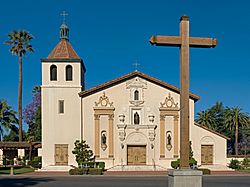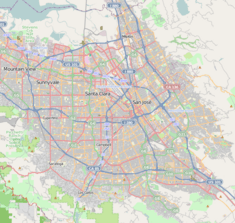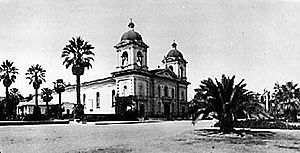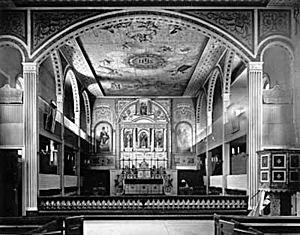Mission Santa Clara de Asís facts for kids

Mission Santa Clara de Asís, shown in 2008
|
|
| Location | Palm Drive and Alviso Street intersection, Santa Clara University, Santa Clara, California |
|---|---|
| Coordinates | 37°20′57″N 121°56′29″W / 37.3493°N 121.9415°W |
| Name as founded | La Misión Santa Clara de Asís |
| English translation | The Mission of Saint Clare of Assisi |
| Founding date | January 12, 1777 |
| Founding priest(s) | Father Presidente Junípero Serra |
| Founding Order | Eighth |
| Military district | Fourth |
| Native tribe(s) Spanish name(s) |
Bay Miwok, Tamyen, Yokuts Costeño |
| Native place name(s) | Socoisuka |
| Baptisms | 8,536 |
| Marriages | 2,498 |
| Burials | 6,809 |
| Neophyte population | 1,125 |
| Secularized | 1836 |
| Governing body | Santa Clara University; Roman Catholic Diocese of San Jose |
| Current use | University of the chapel; Parish church |
| Reference no. | #338 |
Mission Santa Clara de Asís (in Spanish: Misión Santa Clara de Asís) is a Spanish mission located in Santa Clara, California. It was the eighth mission built in California. The Franciscans founded it on January 12, 1777.
The mission was named after Saint Clare of Assisi. She was a close friend of Saint Francis of Assisi. This mission was special because it was the first California mission named after a woman.
Mission Santa Clara gave its name to both the city and county of Santa Clara. It also inspired the name of Santa Clara University. The university was built around the mission. This is the only mission that is part of a university campus.
The mission building has been damaged and rebuilt six times. However, it has never been completely abandoned. Today, it serves as the main chapel for Santa Clara University.
Contents
Mission History
The mission was first called La Misión Santa Clara de Thamien. This name referred to the Tamien Native Americans. It was built in a Native American village called So-co-is-u-ka. This name meant "Laurelwood." The village was located on the Guadalupe River.
Franciscan brothers set up a cross and a place to worship there. They wanted to teach Christianity to the Ohlone people. Floods, fires, and earthquakes often damaged the early buildings. This forced the mission to move to higher ground several times.
The second mission site is known as Mission Santa Clara de Asís. Another site, used from 1784 to 1819, was near the Caltrain tracks. Native American burial sites have been found there. The current mission site, where the first college in Alta California was built, dates back to 1828.
Many Churches of Santa Clara
The mission church has been rebuilt many times. Here is a list of the different churches built over the years:
| Church Number | Years Used | Reason for Change | Materials Used |
|---|---|---|---|
| 1 | 1777-1779 | Flooding | Wood |
| 2 | 1779-1784 | Abandoned | Wood |
| 3 | 1784-1818 | Earthquake, water damage | Adobe |
| 4 | 1818-1825 | Taken down | Adobe |
| 5 | 1825-1926 | Fire | Adobe |
| 6 (same spot as 5) | 1928-present | Still in use | Masonry |
Life at the Mission
At first, there were disagreements between the mission and the nearby town of Pueblo de San Josè. They argued over land and water rights. To help solve this, a road called the Alameda was built. Two hundred Native Americans helped build this road. It connected the two communities.
People from San Jose would come to the mission for church services on Sundays. This continued until St. Joseph's Church was built in 1803. In that year, the mission reported 1,271 Native Americans living there. The priest also reported many animals. There were about 10,000 cattle, 9,500 sheep, and 730 horses. They also harvested a lot of grain.
Changes After Mexican Rule
After Mexico gained independence from Spain, things changed. In 1833, the Mexican government passed a law. This law, called the Mexican secularization act of 1833, meant most of the mission's land and animals were sold. The land was divided and sold to people who could afford it. Often, government officials bought the land. Half of the mission land was given to Native Americans.
Unlike other missions, most of Mission Santa Clara's buildings continued to be used as a church. By 1836, the Mexican government declared the Native Americans at the mission "free." The land around the mission had changed a lot over 60 years. Many native plants needed by the Native Americans were gone. This meant they had to change their way of life.
Many Native Americans moved to the Central Valley of California. Others stayed nearby and worked on new farms called ranchos. Some small Native American villages were started around the Bay Area by 1839. However, many of these villages struggled to support themselves.
The Mission Becomes a University
In 1850, California became a state. In 1851, priests from the Jesuit order took over Mission Santa Clara de Asís from the Franciscans. Father John Nobili, a Jesuit priest, was put in charge. He started a college at the mission site in 1851. This college grew into Santa Clara University. It is the only mission that became part of a university. It is also the oldest university in California.
The mission bells have rung every evening without fail. This promise was made to King Charles III of Spain in 1777. He sent the original bells to the mission. He asked that the bells ring at 8:30 PM each evening to remember those who had died. The original bells have been replaced, but a recording now plays. The bell tower has three bells. One was given by King Carlos IV but was destroyed in a fire. King Alphonso XIII donated a new bell, which is now in the De Saisset Museum.
In 1861, a new wooden front with two bell towers was added to the old adobe building. The inside was made wider in 1885 to fit more people. This meant removing the original adobe walls. A fire in 1925 destroyed the entire structure. The church's regular services moved to the Saint Clare Parish nearby.
A rebuilt Mission Santa Clara was opened in 1929. It then became the main chapel and center of the university campus. Visitors can see it daily. The mission museum is located in the university's De Saisset Museum. The original mission cemetery is still used today. It is on Lincoln Street.
Santa Clara Mission Cemetery
The Santa Clara Mission Cemetery, also called the Santa Clara Catholic Cemetery, was started in 1777. The same Franciscan priests who founded the mission also founded the cemetery. By 1851, when Santa Clara College was founded, the cemetery near the mission was getting full. So, they moved it a short walk away. It was moved near the adobe home of Fernando Berryessa.
In the 1930s, this cemetery built its first indoor mausoleum. A mausoleum is a building where people are buried above ground. Because mausoleum burials became popular, they started building a new outdoor mausoleum complex in 2015.
Famous People Buried Here
- Peter Hardeman Burnett (1807–1895): He was the first elected governor of California. He served from 1849 to 1851.
- Marv Owen (1906–1991): A baseball player for teams like the Detroit Tigers. He was also a baseball coach.
- Cardinal Ignatius Kung Pin-Mei (1901–2000): A Catholic Bishop from Shanghai, China.
- Archbishop Dominic Tang (1908–1995): A Chinese Jesuit priest and later an archbishop.
- Tiburcio Vásquez (1835–1875): A famous bandido (outlaw) in California from 1854 to 1874.
See also
 In Spanish: Misión Santa Clara de Asís para niños
In Spanish: Misión Santa Clara de Asís para niños
- Spanish missions in California
- List of Spanish missions in California
- USNS Mission Santa Clara (AO-132) – a ship named after the mission from World War II.





